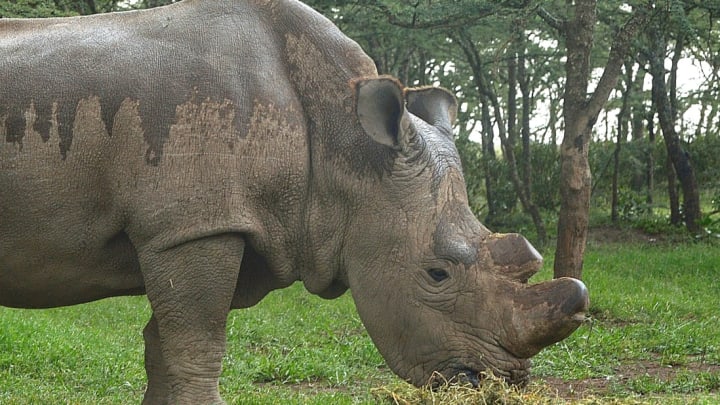Following age-related complications, Sudan—the last male northern white rhinoceros alive—was euthanized by a team of vets in Kenya in March 2018. Sudan, who was 45 years old at the time, was one of only three northern white rhinos left on earth and the last male of his subspecies. For years, Sudan had represented the final hope for the survival of his kind, but before his death scientists came up with a back-up plan: Collecting Sudan's sperm so that they might be able to continue his genetic line even after his death.
Northern white rhino numbers dwindled from 2000 in 1960 to only three in recent years. Those last survivors, Sudan, his daughter Najin, and granddaughter Fatu, lived together at the Ol Pejeta Conservancy in Kenya. Each animal had physical issues making it difficult for them to breed, and with Sudan gone, a new generation of northern white rhinos looks even less likely.
But there is one way the story of these animals doesn't end in extinction. Before Sudan died, researchers were able to save some of his genetic material, which means it's still possible for him to father offspring. Scientists may either use the sperm to artificially inseminate one of the surviving females (even though they're related) or, due to their age and ailments, fertilize one of their eggs and implant the embryo into a female of a similar subspecies, like the southern white rhino, using in vitro fertilization.
"We must take advantage of the unique situation in which cellular technologies are utilized for conservation of critically endangered species," Jan Stejskal, an official at the Dvur Kralove Zoo in the Czech Republic where Sudan lived until 2009, told AFP. "It may sound unbelievable, but thanks to the newly developed techniques even Sudan could still have an offspring."
Poaching has been a major contributor to the northern white rhino's decline over the past century. Rhinos are often hunted for their horns, which are believed to have medicinal properties in some Asian cultures. (Other people just view the horn as a sign of wealth and status.) Procreating is the biggest issue threatening the northern white rhinoceros at the moment. If such poaching continues, other rhino species in the wild could end up in the same situation.
This story has been updated for 2020.
